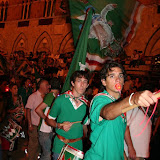Yesterday we got back from 4 days in Umbria where we spent a couple of days in the capital of Perugia and the rest driving around the country and visiting a number of other towns in the region.
Perugia is a lovely town to walk around, with lots of medieval streets, Roman arches and Etruscan history. We visited the major sites, such as the archeological museum, Duomo, etc. but we were most interested by a spot barely mentioned in the guidebooks; the underground passageways within the walls of the old Papal fort, Rocca Paolina.
There is a museum within these passageways and you can learn about the history of the city and the fort. Like many towns in Italy, Umbria was ruled by powerful families and their history is a gripping story of affairs, murder and intrigue. When the Vatican took control of the city in the 1540s they basically built a fort over the houses of these families.
Initially the fort was built as protection from other towns, but a second stage of building showed it was clearly actually to protect the Vatican staff from the townspeople. Obviously the Perugians weren't too excited about being controlled by the church, and were only too happy to blow up the fort during the Italian unification (so enthusiastically, in fact, that a number of people were killed by flying debris).
Nowdays the Perugians realise the historical loss they inflicted upon themselves by destroying the fort, although it is easy to sympathise with the actions of the time. In any case, the underground passageways that remain are an interesting reminder of the city's violent past.
We also made a point of buying some Baci chocolates, which are made by Perugina in a factory near Perugia, and we discovered the Umbrian speciality of pecorino e miele (molten-hot Pecorino cheese and Honey). Linda was also very pleased to find the trattoria she visited the first time she came to Perugia and we had a delicious last meal in town.
All the photos are here.

